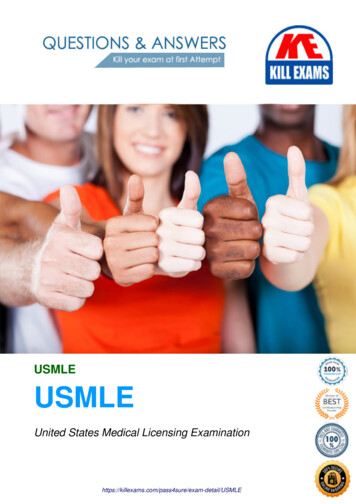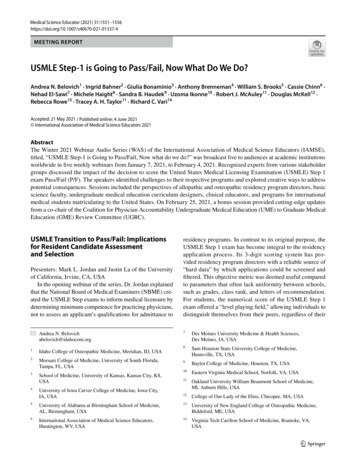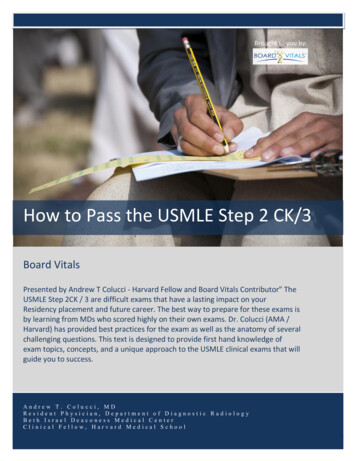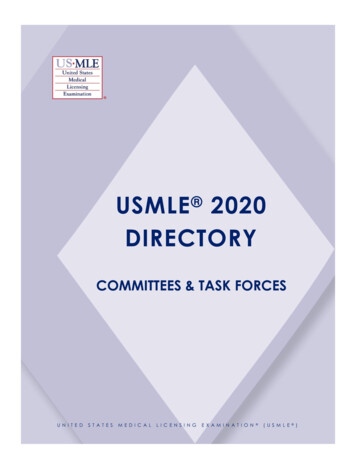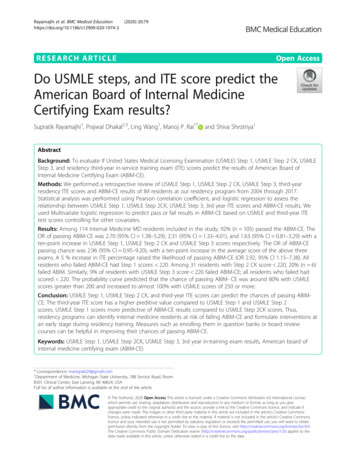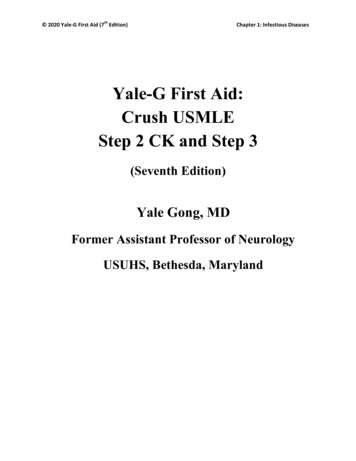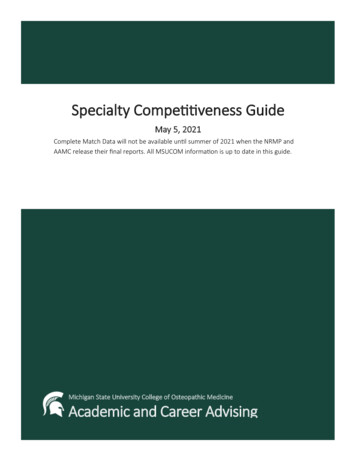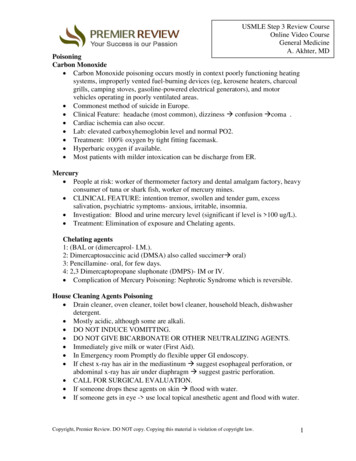
Transcription
USMLE Step 3 Review CourseOnline Video CourseGeneral MedicineA. Akhter, MDPoisoningCarbon Monoxide Carbon Monoxide poisoning occurs mostly in context poorly functioning heatingsystems, improperly vented fuel-burning devices (eg, kerosene heaters, charcoalgrills, camping stoves, gasoline-powered electrical generators), and motorvehicles operating in poorly ventilated areas. Commonest method of suicide in Europe. Clinical Feature: headache (most common), dizziness confusion coma . Cardiac ischemia can also occur. Lab: elevated carboxyhemoglobin level and normal PO2. Treatment: 100% oxygen by tight fitting facemask. Hyperbaric oxygen if available. Most patients with milder intoxication can be discharge from ER.Mercury People at risk: worker of thermometer factory and dental amalgam factory, heavyconsumer of tuna or shark fish, worker of mercury mines. CLINICAL FEATURE: intention tremor, swollen and tender gum, excesssalivation, psychiatric symptoms- anxious, irritable, insomnia. Investigation: Blood and urine mercury level (significant if level is 100 ug/L). Treatment: Elimination of exposure and Chelating agents.Chelating agents1: (BAL or (dimercaprol- I.M.).2: Dimercaptosuccinic acid (DMSA) also called succimer oral)3: Pencillamine- oral, for few days.4: 2,3 Dimercaptopropane sluphonate (DMPS)- IM or IV. Complication of Mercury Poisoning: Nephrotic Syndrome which is reversible.House Cleaning Agents Poisoning Drain cleaner, oven cleaner, toilet bowl cleaner, household bleach, dishwasherdetergent. Mostly acidic, although some are alkali. DO NOT INDUCE VOMITTING. DO NOT GIVE BICARBONATE OR OTHER NEUTRALIZING AGENTS. Immediately give milk or water (First Aid). In Emergency room Promptly do flexible upper GI endoscopy. If chest x-ray has air in the mediastinum suggest esophageal perforation, orabdominal x-ray has air under diaphragm suggest gastric perforation. CALL FOR SURGICAL EVALUATION. If someone drops these agents on skin flood with water. If someone gets in eye - use local topical anesthetic agent and flood with water.Copyright, Premier Review. DO NOT copy. Copying this material is violation of copyright law.1
USMLE Step 3 Review CourseOnline Video CourseGeneral MedicineA. Akhter, MDMethanol Usually after drinking bootleg whiskey, comes with visual disturbance. PE: mydriasis, hyperemia of optic disc. Lab: Anion gap metabolic acidosis, osmolal gap, serum methanol level. Treatment: Fomepizole (antidote of choice)- IV. Alternative: ethanol. hemodialysis for severe toxicity 50 mg/dL.Ethylene Glycol Secondary to ingestion of antifreeze solution. Clinical Feature: confusion, tachypnea. Lab: Anion gap metabolic acidosis, urine test has oxalate crystal, osmolal gap. Treatment: same as methanol poisoning.Organophosphate insecticide History of insecticide spray or a farmer coming from work. Complaints: Abdominal pain, diarrhea, vomitting, Shortness of breath. Physical Exam: Miosis (constricted pupil), sweating, wheezing. Treatment: Wash the skin with soap and waterAtropine I.V. decreases sweating and wheezingPralidoxime (2-PAM) I.V –specific antidoteSalicylate Poisoning Nausea, vomiting, tinnitus, tachypnea Lab: metabolic acidosis and respiratory alkalosis Treatment: Alkalinize urine by sodium bicarbonate I.V. Hemodialysis for severe acidosis or altered mental statusBlack Widow Spider Bite Clinical Feature: generalized muscular pain, muscle spasm, rigidity. Treatment: parenteral narcotic – for pain. Muscle relaxant- methocabomol I.M. or I.V. for spasm. Calcium gluconate I.V. for rigidity Rarely antivenin I.V.Brown Recluse Spider Bite Clinical Feature: extensive local necrosis and hemolytic reaction, may not be feltat all or only as a pinprick. Lesion is small 2cmo supportive measures: dress the wound, tetanus toxoid, rest, analgesics andclose follow up Large massive necrotic lesion 2cmo Treat with systemic corticosteroids 5-7 days.Opioid IntoxicationCopyright, Premier Review. DO NOT copy. Copying this material is violation of copyright law.2
USMLE Step 3 Review CourseOnline Video CourseGeneral MedicineA. Akhter, MDMorphine, Codeine, Heroin, Meperidine, Methadone, Oxycontin.Clinical Feature: Euphoria, drowsiness, constricted pupil, hypotension,bradycardia, hypothermia and respiratory arrest.Seizure, likely secondary to Meperidine especially in patients with renal failuredue to accumulation of metabolite: nor-meperidine.Duration of effect of Heroin: 3-5 hr.Methadone intoxication may last 48-72 hrs.Most opioids are detectable on routine urine toxicology except Methadone, newerFentanyl derivative.Treatment: Naloxone 0.4 mg to 2 mg IV.Duration of effect of Naloxone is 2-3 hr.Repeated dosage required for patients intoxicated with Methadone.Patient should be observed at least 3 hours after the last dose of Naloxone.PoisoningBeta BlockerAcetaminophenCarbon hanol, ethylene glycolMethemoglobinemiaSpecific AntidoteGlucagonAcetylcysteine100% OxygenFlumazenilNitrite (Amyl nitrite, Sodium nitrite)Fab antibody fragment (digibind)NaloxoneDefuroxamineFomepizoleMethylene blueSnake Bite Venom could be cytolytic (Rattle snake, other Pit Vipers) most common in USA.Or Neurotoxic (Coral Snake). Cytolytic venom causes tissue destruction by digestion and hemorrhage due tohemolysis and destruction of endothelial lining of blood vessels. Manifestation: local pain, redness, swelling, extravasation of blood, nausea,vomiting, hypotension, coagulopathy may also occur. Neurotoxic venom causes ptosis, diplopia, dysphagia, respiratory paralysis.ManagementIn field: Immobilize the patient and bitten part in neutral position. Avoid manipulation of bitten area. Avoid any stimulant. Do not apply ice.Copyright, Premier Review. DO NOT copy. Copying this material is violation of copyright law.3
USMLE Step 3 Review CourseOnline Video CourseGeneral MedicineA. Akhter, MDDo not apply tourniquet.Incision and suction by unskilled people is not justified (in view of small amountof venom that can be recovered).Transport pt to nearest facility.In hospital: Labs: CBC, Chem 7, CPK, PT, PTT, Urine for myoglobin. If no local or systemic signs and symptoms and coagulation profile normal discharge home in 12 hours.Specific Antidote: Pit Vipers (Rattle Snake): Crotalid antivenin (CroFab). Slow IV in normal saline,antihistamine, keep epinephrine ready in case of anaphylactic reaction. Oxygen, IV fluid, Asses need for Tetanus toxoid, antibiotic (Augmentin). Coral Snake: For specific antivenin- call the regional poison center they help youto locate antisera. Horse serum based antivenom is available in USA.Follow up: Adequacy of treatment is indicated by clinical signs and symptoms and rate ofswelling slows down, also follow up the coagulation profile.COMA:DO NOT FORGET ABC: Control airway, oxygen, pulse oximeter, intubation. If trauma- first immobilize cervical spine with hard collar (until you r/o fractureor instability. IV line, cardiac monitor, check cardiac monitor. Vitals: stabilize it, if hypotensive start Inravenous normal saline, vasopressors(dopamine, norepinephrine) Order: finger stick, CBC, Chem 7, LFT, ammonia, ABG, PT, PTT, type andcross match, blood cx, UA, urine toxicology, blood toxicology screen, alcohollevel, serum osmolality, urine osmolality, cardiac enzyme, portable chest x-ray,EKG, Foley catheter. IV thiamine 50% dextrose 50 cc IV Naloxone IV Flumazenil IV- if the suspicion of Benzodiazepine is high. (Routine use is notadvisable since it can cause Seizure) Exam: look for signs of head trauma, cirrhosis, sepsis, rash of meningococcemia. Look at the pupils:o Small but reactive narcotic overdose or metabolic encephalopathy.o Dilated fixed unilateral r/o uncal herniation hyperventilation,mannitol IV, dexamethasone IV, urgent neurosurgery consult -- CT head.o Dilated, fixed bilateral drug intoxication with methyl alcohol or severeanoxic encephalopathy. If patient is febrile vancomycin and gentamycin IV.Copyright, Premier Review. DO NOT copy. Copying this material is violation of copyright law.4
USMLE Step 3 Review CourseOnline Video CourseGeneral MedicineA. Akhter, MD Follow up labs: If serum osmolality high and anion gap metabolic acidosis,hyperemia of optic disc Fomepizole. If vitals stable CT head non diagnostic Lumbar puncture. Send CSF for cell count, cx, glucose, protein. Still undiagnosed EEG (to diagnose non convulsive status epilepticus,encephalitis, encephalopathy)CCS Case: ComaLocation: Emergency RoomCC: UnresponsiveVitals: B.P is 120/60mm of Hg. Pulse is 100 /minute. Temperature is 990F,RR is10-12/minute.History of Present Illness:30-year-old male brought by his girlfriend as was found unresponsive in his apartment. Abottle of liquor 75% empty and couple of bottles of medicines of anxiety were emptynear him.Past Medical History: Alcohol Abuse, Anxiety, Depression.Personal History: Smokes one pack of cigarette daily. Smoked Marijuana five years ago.Drinks alcohol everyday. No history of IV drug abuse.Allergy- UnknownFamily History- Unknown.DO NOT FORGET ABCOrder:Airway oral (To maintain the patency of airway)Oxygen- continuousPulse oximeterCardiac monitorIntravenous accessIntravenous fluid- Normal salineFinger stick- glucoseResults:Pulse oximeter should have oxygen saturation more than 90%, if it is less than 90% Intubation.Note: If history is suggestive of some poisoning, and you are planning to do gastricLavage, in a comatose patient, always intubate prior to gastric Lavage. Gastric Lavage isCopyright, Premier Review. DO NOT copy. Copying this material is violation of copyright law.5
USMLE Step 3 Review CourseOnline Video CourseGeneral MedicineA. Akhter, MDnot being used routinely, except if you have clear history of ingestion of life threateningamount of toxin and patient presents within 60 minutes of ingestion of the substance, ifthey want you to do gastric Lavage, history will be “patient took this medication, thismany pill, while arguing with a family member or friend who brought the patient to thehospital.” If patient is conscious, you can perform gastric Lavage, without intubation. Butif patient is unconscious, first intubate before gastric Lavage.Again order battery of test and procedure:CBC, Chem8, Liver Function Test (LFT), Ammonia, Arterial Blood Gas (ABG), PT,PTT, Type and cross match, blood c/s, Cardiac enzyme, Blood toxicology screen,Blood Alcohol level, Serum osmolality, X-ray chest AP- Portable, EKG, Foley’s catheterU/A, Urine toxicology, Urine OsmolalityAfter above orders, Order the following in the same sequence.Thiamine therapy- I.V one time bolus Dextrose 50% in water- I.V. stat.Naloxone I.V one time bolusFlumazenil I.V. one time bolusNote: Thiamine is give before the administration of Dextrose, because, if dextrose isadministered in a Thiamine deficient patient it can precipitate, Wernicke’sEncephalopathy. Usually thiamine deficiency occurs in Alcoholics.If patient becomes conscious after the administration of I.V. Naloxone, suggest opiateintoxication. If this patient again becomes unconscious, suggest long acting opiateintoxication eg: Methadone, which will need multiple dosages of Naloxone I.V.If patient becomes conscious after the administration of Flumazenil, suggestsBenzodiazipine intoxication.Patient did not respond to above treatment. If Urine toxicology result becomes availableand is positive for benzodiazepine this does not mean patient has benzodiazepinetoxicity, since patient did not respond to Flumazenil. Although benzodiazepine waspositive in urine because patient has history of anxiety and was on benzodiazepine.Scenario 1:If patient has hypotension and EKG shows Arrhythmia (Prolonged PR, QRS and QTinterval) likely diagnosis is Tricyclic Antidepressant poisoning. (since patient has historyof depression and anxiety) Order Sodium bicarbonate I.V. continuous.Check vitals, if vitals remain stable, order CT scan of the head. If the scan report isnormal, transfer the patient to the Intensive care unit.Follow up serum and urine toxicology to confirm, the diagnosis of TCA poisoning.Scenario 2:Copyright, Premier Review. DO NOT copy. Copying this material is violation of copyright law.6
USMLE Step 3 Review CourseOnline Video CourseGeneral MedicineA. Akhter, MDIf patient has not responded to above cocktail, look into the examination HEENTfinding dilated pupils, hyperemia of optic disc check labs serum osmolality Serum osmolality high check anion gap (Anion gap 14) Anion gap metabolicacidosis check U/A- normal. No crystals most likely diagnosis Methanolpoisoning Start IV Fomepizole (or Ethanol).Check vitals, if vitals remain stable, order CT scan of the head. If the scan report isnormal, transfer the patient to the Intensive care unit.Scenario 3:If patient has not responded to above cocktail, look into the examination HEENTfinding Pupils are normal check labs serum osmolality Serum osmolalityhigh check anion gap (Anion gap 14) Anion gap metabolic acidosis check U/Acalcium oxalate crystals most likely diagnosis Ethylene Glycol (anti-freeze)poisoning Start IV Fomepizole (or Ethanol).Check vitals, if vitals remain stable, order CT scan of the head. If the scan report isnormal, transfer the patient to the Intensive care unit.Scenario 4:If patient has not responded to above cocktail, look into the examination HEENTfinding pupils are normal check labs serum osmolality Serum osmolalityhigh check anion gap Anion gap- normal ( 12 2) check U/A increased ketonesin the urine, no crystals Order serum ketone. Follow up the serum toxicology result,which tells you about isopropyl alcohol level most likely diagnosis IsopropylAlcohol poisoning Treatment is supportive, continue above management.Check vitals, if vitals remain stable, order CT scan of the head. If the scan report isnormal, transfer the patient to the Intensive care unit.Primary Immune DeficiencyCommon Variable Immune deficiency disease (CVID) Abnormality in B-cell function. Presents between one year to adulthood. When onset is in adulthood, they may have underlying lymphoid malignancy. Presents with recurrent bacterial infection involving sinuses, middle ear, lung withsystemic spread. Treatment: IVIG lifelong.Hyper IgE syndrome (Job’s syndrome) Recurrent skin and visceral (hepatic, renal, pulmonary perianal ) abscess. Mostly secondary to staphylococcal infection. Elevated IgE level.DiGeorge SyndromeCopyright, Premier Review. DO NOT copy. Copying this material is violation of copyright law.7
USMLE Step 3 Review CourseOnline Video CourseGeneral MedicineA. Akhter, MDrdth Secondary to deletion of chromosome 22q11, development of 3 and 4 pharyngealpouch gets affected, causing anomaly of face, thymus, parathyroid and cardiacstructures. Triad of;1) Absent T cells, secondary to absence of thymus2) Congenital heart disease3) Hypocalcemia secondary to hypoparathyroidismDiagnosis: Characteristic facial appearance {cleft palate, small mouth, low set ears, shortpalpebral fissure, widened distance between the inner canthi (telecanthous) } Congenital heart disease (Tetralogy of fallot, Truncus arteriosus, atrial and ventricularseptal defect) Hypocalcemia (presents with tetany, seizure) Treatment: Bone marrow transplantWiscott-Aldrich syndrome Mix of immunoglobulin defect and T cell deficiency. Clinical Features: Eczema- develops during first year of life, resembles atopicdermatitis. Thrombocytopenia- presenting with bleeding. Characteristic immunoglobulin pattern IgG normal IgM very low, IgA and IgEelevated. Prone to have infection with encapsulated organisms due to immunoglobulin defect. Increased incidence of non Hodgkin’s lymphoma. Treatment: Bone marrow transplant. If bone marrow transplant not feasible due to absence of HLA matched donor,splenectomy is the treatment of choice for patients with platelet count less than 50,000. IVIG- every 3 to 4 weeks. Antibiotic prophylaxis- Amoxicillin or Trimethoprim- sulfamethoxazole daily.Severe combined immunodeficiency disease (SCID) Absence of both cellular and humoral immunity. Usually symptoms starts in newborn period. Classical symptoms are recurrent severe infection, chronic diarrhea and failure tothrive. Chronic mucocutaneous candidiasis is a common early finding. Attenuated vaccine such as OPV can cause severe infection.Copyright, Premier Review. DO NOT copy. Copying this material is violation of copyright law.8
USMLE Step 3 Review CourseOnline Video CourseGeneral MedicineA. Akhter, MDBlood transfusion can cause graft-versus-host disease (GVHD).Lab: lymphopenia ( absolute lymphocyte count less than 2000/mm3 in a newborn is anabsolute indication for evaluation of SCID). Hypoglobulinemia. Impaired specific antibody response. Cutaneous anergy. Treatment: Bone marrow transplant.Adenosine deaminase deficient SCID: Profound lymphopenia (absolute lymphocyte count less than 500/mm3) Chondro-osseous dysplasia of costochondral junction. Vertebral bodies reveal “Rachitic Rosary” rib cage.Chediack Higashi Syndrome: Phagocytic disorder- Neutrophils contain abnormal “ Giant” granules due toinappropriate fusion of lysosomes and endosomes. Recurrent pyogenic infection. Partial oculocutaneous albinism. Neurologic abnormality (Photophobia, Nystagmus, Peripheral neuropathy, seizure,dysfunction of spinal tract and cerebellum).IgA deficiency: Most common primary immunodeficiency. Predominent immunoglobulin of nasal secretion is IgA. Most patients are asymptomatic but may develop recurrent sino-pulmonary infection,recurrent gastrointestinal infection, particularly giardia lamblia (secretory IgA usuallybinds with pathogens and toxins). Anaphylactic blood transfusion reaction.Ataxia Telangiectasia: Progressive cerebellar ataxia since the beginning of walking (appear healthy for thefirst year of life) which slowly gets worst and by 10-12 years of age, becomewheelchair bound. Ocular or facial Telangiectasia (mostly appear when child is 3-5 year of age) . Elevated alpha-feto protein is found in more than 95% patients over the age of 8months. Immunodeficiency, Absent or low IgA and IgE level, mostly develop sino-pulmonaryinfections. No effective treatment.Vitamin DeficiencyCopyright, Premier Review. DO NOT copy. Copying this material is violation of copyright law.9
USMLE Step 3 Review CourseOnline Video CourseGeneral MedicineA. Akhter, MDVitamin deficiency syndromes develop gradually, symptoms are non specific andphysical exam is rarely helpful in early diagnosis.Some vitamins can be used efficaciously as drugs.o Vitamin A derivatives: Treat cystic acne and skin wrinkles.o Niacin: Treats hyperlipidemia.Vitamin A Deficiency Important for normal retinal function, wound healing and cell growth anddifferentiation. Causes: Fat malabsorption syndromes and mineral oil laxative abuse, it occurscommonly in the elderly and urban poor in the US.CLINICAL FEATURE: Night blindness, xerosis (dryness of the conjunctiva),Bitot’s spots, Keratomalacia, perforation, endophthalmitis and blindness.Treatment: Vitamin A 30,000 IU/day x 1 week for early deficiency.Toxicity: staining of the skin orange-yellow, and with hypervitaminosis- dry scalyskin, hair loss, mouth sores, painful hyperostosis, anorexia and vomitting early on.Late findings- hypercalcemia, increased ICP, cirrhosis.Vitamin A derivatives also used to treat Cystic Acne and Skin wrinkles,remember however it is teratogenic, therefore always do a pregnancy test infemales of child bearing age. Topical use can increase the risk of skin cancerVitamin B1 (Thiamine) Deficiency Causes: alcoholic, chronic dialysis CLINICAL FEATURE:o Wet beriberi: Symptoms are cardiovascular: heart failure, ascites, edema.o Dry beriberi: Symptoms are neurological-both peripheral and central:o Wernicke’s encephalopathy (nystagmus, ophthalmoplegia, ataxia,change in mental status).o Korsakoff’s psychosis (confabulation, and retrograde amnesia). Treatment: large parenteral doses 50-100 mg/day for first few days, followed bydaily doses 5-10 mg/day.Vitamin B2 (Riboflavin) Deficiency Causes: drugs (phenothiazine, tricyclic antidepressants) CLINICAL FEATURE: Glossitis, cheilosis, angular stomatitis, seborrheicdermatitis, weakness, corneal vascularization and anemia. Treatment: meat, fish, dairy or oral preparation of vitamin 5-15 mg/day.Vitamin B6 (Pyridoxine) Deficiency Causes: patient on INH, Penicillamine, OCPs, or alcoholism. CLINICAL FEATURE: mouth soreness, glossitis, cheilosis, if severe: peripheralneuropathy, seizure. Treatment: oral supplements 10-20 mg/day, typically given with INH.Copyright, Premier Review. DO NOT copy. Copying this material is violation of copyright law.10
Toxicity: irreversible sensory neuropathy on high doses.USMLE Step 3 Review CourseOnline Video CourseGeneral MedicineA. Akhter, MDNiacin Deficiency Causes: Historically it occurred when corn, which is relatively deficient in niacinwas the major source of calories. Today: Alcoholism, INH, Carcinoid syndrome. CLINICAL FEATURE: Pellagra- 3D (diarrhea, dementia, dermatitis) and ifadvanced even death. Treatment: oral doses 10-150 mg/day. It is also used to treat hyperlipidemia. Toxicity: can be seen when treating hyperlipidemia, Cutaneous flushing (to avoidpre-treat with Aspirin 325 mg/day).Vitamin C Deficiency Potent antioxidant, also required for the synthesis of collagen. Increases absorption of Iron. Decreases effect of Warfarin. Causes hyperoxaluria. CLINICAL FEATURE: Scurvy (Due to impaired collagen synthesis). Symptomsare bleeding gum, ecchymoses, petechiae, hyperkeratosis, impaired woundhealing, weakness, joint pain and swelling, neuropathy. Treatment: Ascorbic acid 300-1000 mg/day. Toxicity: gastric irritation, flatulence, and diarrhea at high doses. Fecal occultblood could be false negatives and urine glucose could be false positives.Vitamin D Deficiency Causes: insufficient sun exposure, malnutrition, malabsorption, rickets,anticonvulsants, often seen in institutionalized elderly. CLINICAL FEATURE: osteomalacia, osteopenia Treatment: Sunlight, Vitamin D supplements.Vitamin E Deficiency Functions as an antioxidant, protecting cell membranes and other structures fromthe attack of free radicals. Investigational use to prevent Alzheimer's. CLINICAL FEATURE: Hemolysis, Ataxia, Myopathy.o Increases effect of Warfarin (Causes Vitamin K deficiency). Treatment: oral doses of 100-400 units/day. Toxicity: nausea, diarrhea, and may cause bleeding in those taking coumadin.Vitamin K: Factor II, VII, IX ,X , protein C and S are vitamin K dependent clotting factors Causes: poor diet, malabsorption, broad spectrum antibiotics. CLINICAL FEATURE: bleeding from venipuncture site Treatment: Subcutaneous vitamin K supplementSelenium: Deficiency of Selenium can cause Congestive Heart FailureChromium: Deficiency of chromium can cause Insulin ResistanceCopyright, Premier Review. DO NOT copy. Copying this material is violation of copyright law.11
Zinc: Deficiency of Zinc can cause delayed wound healingUSMLE Step 3 Review CourseOnline Video CourseGeneral MedicineA. Akhter, MDComplications of modern day hobbies:Tanning beds: Addictive, can cause basal cell carcinoma especially in women whoare taking OCP or Antihistamine.Hair Removal: Eflornithine (ornithine decarboxylase inhibitor) is FDA approvedfor the use of abnormal facial hair.Complication: Reversible Anemia, Leucopenia.Laser Hair removal: Side effect could be hypo-pigmentation, flare up of Acne, andPurpura.End of 1st HourCopyright, Premier Review. DO NOT copy. Copying this material is violation of copyright law.12
MedicineSt. John’s WortDepressionSaw PalmettoBenign Prostatic HypertrophyGinsengFatigue, DiabetesWitch HazelGinkgoHemorrhoids and tes to increaseperformanceAnti-aging agent, sexualenhancer, depressionSympathomimetic used forweight loss, stimulantUsed in chewing gum andchewing tobacco.DHEAEphedraLicoriceBlack Cohosh:Also known asActaea racemosa L.CimicifugaracemosaBlack SnakerootBugwortMacrotysRattle RootRattle WeedUseActive ingredient:Phytoestrogens: estrogen likeeffect, helps in menopausalsymptomsIsoferulic acid- aspirin likeeffect helps in rheumatic pain.USMLE Step 3 Review CourseOnline Video CourseGeneral MedicineA. Akhter, MDCommentAvoid with SSRIActivates Cytochrome P450systemand so decreases the plasmaconcentration of Theophylline,Cyclosporine, Indinavir, Warfarin,Digoxin, Simvastatin, OralcontraceptiveImproves urinary symptomsDoes not decrease Prostate size orPSA levelMay cause HypertensionHypertension, HypoglycemiaExternal use has no side effect.Avoid with NSAID, Warfarin,Heparin increased risk of bleedingAvoid in renal failureHypertension, arrhythmia, stroke.Inhibits 11βhydroxy steroiddehydrogenase which convertsCortisol to Cortisone, if Cortisollevel is high, it will stimulateAldosterone receptors. Patient willhave symptoms of primaryhyperaldosteronism likehypertension, hypokalemia,andmetabolic alkalosis.Side effect: Nausea, vomiting andhypotension.Caution when used: patient takinganticoagulant and antihypertensivemedication. Patient havingundiagnosed uterine bleeding.Copyright, Premier Review. DO NOT copy. Copying this material is violation of copyright law.13
USMLE Step 3 Review CourseOnline Video CourseGeneral MedicineA. Akhter, MDGeriatricsChanges in physiologic function with ageOrgan SystemSpecial alImmuneEndocrineAutonomic NervousNeurologicMusculoskeletalAge-Related Decline in FunctionPresbyopiaLens opacificationDecreased hearingDecreased taste and smellImpaired intrinsic contractile functionDecreased conductivityDecreased ventricular fillingIncreased systolic blood pressureImpaired baroreceptor functionDecreased lung elasticityDecreased maximal breathing capacityDecreased mucous clearanceDecreased arterial PO2Decreased esophageal/colonic motilityDecreased Glomerular filtration rateDecreased cell mediated immunityDecreased T-cell numberIncreased T-suppressor cellsDecreased T-helper cellsLoss of memory cellsDecline in Ab titers to known AgIncreased autoimmunityDecreased hormonal responses to stimulationImpaired glucose toleranceDecreased Androgens and EstrogensImpaired norepinephrine responseImpaired response to fluid deprivationDecline in baroreceptor reflexIncreased susceptibility to hypothermiaDecreased vibratory senseDecreased proprioceptionDecreased muscle massSensory Impairment Hearing:o The most common cause of hearing loss is sensorineural: Presbycusis.o Screening test: Hearing Handicap Inventory for the Elderly- ScreeningVersion (HHIE-S), whispered voice test, audioscopy.o Hearing loss leads to social isolation and depression.Copyright, Premier Review. DO NOT copy. Copying this material is violation of copyright law.14
USMLE Step 3 Review CourseOnline Video CourseGeneral MedicineA. Akhter, MDVision:o The most common causes of age related visual impairment: Age relatedmacular degeneration (AMD), cataracts, glaucoma.o AMD- leading cause of blindness in those 65.o Screening test: Snellen or Jaeger eye chart.Q: 87 yo M, living in an assisted living home, recently became socially isolated, no longervisiting with friends, eating in the common dining room or watching television. Vitals are allstable. All labs WNL. Geriatric depression score 1/5. (low risk for depression) What to do?A:Q: An 81-year-old man is evaluated for a 6-month history of a constant buzzing sound in bothears. The noise interferes with reading, watching television, and sleep. He denies headache,vertigo, or sinus pain. Depression screening results are negative. Vitals are stable, PE normal.What to do?A:Cognition The prevalence of dementia doubles every 5 years after age 60, by the age of 85about 30-50% of individuals have some degree of impairment. Short term memory is important to inquire about, finding out whether patientshave difficulty forgetting to take medications, forgetting appointments or gettinglost while driving. Screening test: Folstein Mini-Mental State Examination- 24/30 is significant.Level of education can affect performance. Identification of dementia early can identify potentially reversible causes likefolate, B12 deficiency, syphilis, hypothyroidism, depression. Treatment for dementia:o Donepezil, a centrally acting cholinesterase inhibitor modestly improvescognition, global function, and psychiatric symptoms.o Memantine, is recommended for patients for moderate to severeAlzheimer’s.o Vitamin E, may help slow progression.Q: A 78-year-old F concerned that she is losing her memory visits her primary carephysician accompanied by her daughter. The daughter confirms that the patient is forgetfuland does not recall conversations that have occurred in recent days. The patient appearscheerful, physical exam: well-groomed and friendly. Which of the following is the mostappropriate next step in the assessment of this patient's cognitive impairment?A:Depression A simple 2 question screen has shown 96% sensitivity for detecting majordepression in the general population, and even higher in those 65.o In the last month have you often been bothered by feeling sad, depressedor hopeless?Copyright, Premier Review. DO NOT copy. Copying this material is violation of copyright law.15
USMLE Step 3 Review CourseOnline Video CourseGeneral MedicineA. Akhter, MDo In the last month have you often been bothered by little interest orpleasure in doing things.Q: A 66-year-old man is having difficulty concentrating and performing work as managerfor 6 months, H/o depression, treated with antidepressants for 6 mo. On examination, hereplies slowly to questions and has Mini–Mental State Examination score of 26/30. Onneuropsychological examination, he has impairments of attention and speed of proce
USMLE Step 3 Review Course Online Video Course General Medicine A. Akhter, MD not being used routinely, except if you have clear history of ingestion of life threatening amount of toxin and patient presents within 60 minutes of ingestion of the substance, if they want you to do gastric Lavage, history will be "patient took this medication, this


